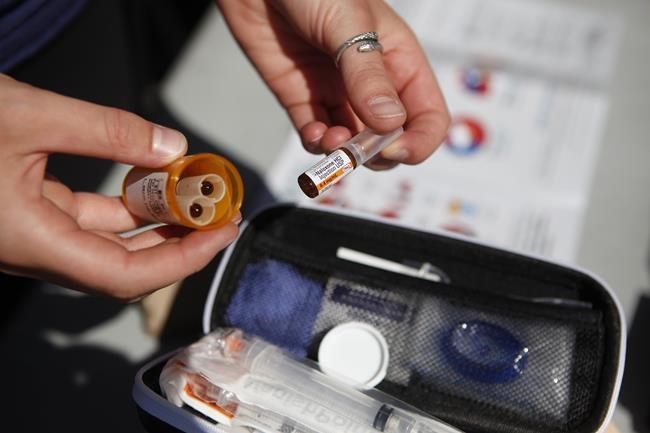TORONTO — Some "high-risk" businesses in Ontario must have opioid antidotes on site and the training to use it by June, the province announced Wednesday.
The provincial government will help small businesses who qualify for the program become compliant by providing free naloxone kits and training, Labour Minister Monte McNaughton said.
"We're past the point of talking. We need all hands on deck to end the stigma surrounding opioid overdoses and dependency so we can save lives," he said at a downtown Toronto bar.
Employers must have naloxone and training if they become aware that a worker could overdose on opioids, that they could overdose while on the job, and that the risk is posed by a worker of the employer. If only one of those scenarios applies, the employer is not required to comply.
The province deems a risk of a worker overdosing on opioids to mean that an employee overdose has previously happened in the workplace, a worker has disclosed that they use opioids, an employer has observed or discovered opioid use by workers or the employer has found opioid paraphernalia such as needles in the workplace.
The province passed legislation last spring mandating that naloxone kits be available in high-risk workplaces such as construction sites, bars and restaurants.
"The goal is to get more kits into more hands because we know that's what's going to save lives," McNaughton said.
Naloxone can temporarily reverse an opioid overdose if given quickly, which can buy time until emergency responders show up.
Data from the Office of the Chief Coroner shows 2,819 people died from opioids in 2021.
Opioid deaths have increased by more than 100 per cent since 2017 and took a marked jump when the pandemic hit in March 2020.
Health experts say a toxic drug supply along with a dearth of harm reduction services like safe consumption sites and methadone clinics are partly to blame for the ongoing crisis.
McNaughton previously said the province hoped to have the kits in establishments by this past summer.
"We've been working throughout this year since the legislation passed to have those requirements brought forward," he said when asked about the delay.
McNaughton said he hopes naloxone kits will become ubiquitous throughout the province one day.
"With more than 300,000 businesses across Ontario, by the end of the decade I want every employer in our province to have one of these kits, just like they do a defibrillator," he said.
Recently released data from the Office of the Chief Coroner shows the rate of opioid deaths decreased in the first six months of this year compared to last.
Preliminary data from the coroner's office shows 1,278 people have died from opioid toxicity in the first six months of this year. There were 1,487 deaths in the same time period last year.
Opioids have still killed Ontarians at a rate 55 per cent higher than in 2019, before the pandemic hit.
About 30 per cent of workers who died from opioids occurred in the construction industry.
"I know only a small minority of opioid related deaths occur in workplaces, but I'll be damned if we don't do our part in helping save lives," McNaughton said.
Fentanyl remains the major contributor with the substance found in 85 per cent of deaths this year. Other drugs like cocaine, methamphetamine and non-pharmaceutical benzodiazepines are also found in a significant number of opioid deaths.
Opioids are killing more people per capita in rural and northern Ontario, and is disproportionately killing homeless people and the unemployed, research has found.
This report by The Canadian Press was first published Dec. 14, 2022.
Liam Casey, The Canadian Press

